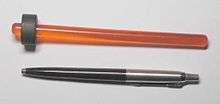Microphonics

Microphonics or microphony describes the phenomenon wherein certain components in electronic devices transform mechanical vibrations into an undesired electrical signal (noise). The term comes from analogy with a microphone, which is intentionally designed to convert vibrations to electrical signals.
Description
When electronic equipment was built using vacuum tubes, microphonics were often a serious design problem. The charged elements in the vacuum tubes can mechanically vibrate, changing the distance between the elements, producing charge flows in and out of the tube in a manner identical to a capacitor microphone. A system sufficiently susceptible to microphonics could experience audio feedback, and make noises if jarred or bumped. Certain vacuum tubes were made with thicker internal insulating plates and more supports to minimize these effects.[1]
A special tool, called a valve hammer, or tube hammer was sometimes used to safely tap the device suspected of being microphonic, while it was operating, so checking if such a tap would produce objectional audio effects.

With the advent of solid-state electronics (transistors), this major source of microphonics was eliminated but smaller sources still remain.
The ceramic EIA Class 2 dielectrics used in high-K capacitors ("Z5U" and "X7R") are piezoelectric and directly transform mechanical vibration into a voltage in exactly the same way as a ceramic or piezoelectric microphone.[2] Film capacitors using soft (mechanically compliant) dielectric materials can also be microphonic due to vibrational energy physically moving the plates of the capacitor. Likewise, variable capacitors using air as a dielectric are vulnerable to vibrations moving the plates. Capacitors using glass as the dielectric, while quite expensive, can be made to be essentially nonmicrophonic.
Wiring and cables can also exhibit microphonics as charged conductors move around, and various materials can develop triboelectric ("static") charges that couple to the electronic circuits.
Guitar amplifiers that incorporate the electronic chassis into the same cabinet as the speaker are susceptible to microphonics. Though a guitar amplifier's microphonics distortion is sometimes appreciated as part of the "special sound" of a guitar amplifier, a faulty vacuum tube or other component can cause out-of-control positive feedback. Unwanted microphonics-related audible distortions can often be alleviated by using commercially available vacuum tube mechanical dampers.
The term may also be used to describe a video artifact common in older video cameras. Before the introduction of solid-state CCD sensors to produce the image, vacuum tubes performed this task. Loud noises in the studio, such as rock bands or gunshot effects would cause the tubes to vibrate, producing a characteristic undesirable horizontal banding in the image.[3]
Other uses
The term is sometimes misused to describe sounds transmitted to the ear physically by mechanical vibrations or knocks on the wires of a headphone or in-ear monitor, when no disturbance of any electrical signal occurs.[4]
See also
References
- ↑ Robert B. Tomer, Getting the most out of vacuum tubes, Howard W. Sams, Indianapolis, USA 1960, Library of Congress card no. 60-13843, available on the Intenet Archive. Chapters 3
- ↑ , Capacitors for reduced sound emissions.
- ↑ http://www.michaeldvd.com.au/Articles/VideoArtefacts/VideoArtefactsMicrophony.html
- ↑ "In-ear-canal headphone primer" by Dan Frakes, Capsule Review, Macworld, 31 January 2007